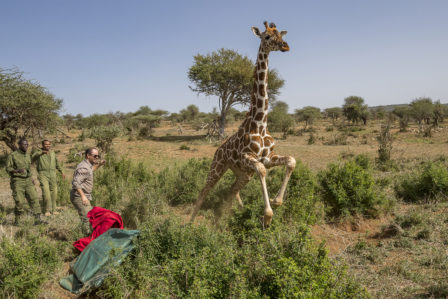Conservationists Take Giraffe Surveillance to New Heights

This is the first time such a large group of giraffes will be tracked for multiple years in East Africa. Photo courtesy of San Diego Zoo Global.
In a remote area of northern Kenya, a team of conservationists and veterinarians are collaborating on a unique project that will allow them to gather in-depth information on the habits of Kenya’s threatened reticulated giraffe population. The science team, made up of personnel from multiple conservation organizations, has attached solar-powered GPS satellite tracking devices to 11 reticulated giraffes in the region. The units will provide the science team with real-time data on giraffe movements, the size of their home ranges, where they travel during seasons and the travel corridors they use over the next two years—making this the first time such a large group of giraffes will be tracked for multiple years in East Africa.
“It’s so exciting,” said Julian Fennessy, Ph.D., co-founder/co-director of the Giraffe Conservation Foundation. “We want to figure out where these giraffes are moving, so we can better provide conservation management support, whether that be anti-poaching support on the ground, working with communities, all the way to helping a sick giraffe and bringing in the Kenya Wildlife Service to help.”
Attaching these small devices to 11 wild giraffes was not an easy task, requiring years of planning and detailed preparation. The team first had to find, corral and sedate each giraffe—making sure every step was performed with the utmost care and attention to detail.
Through these efforts, researchers have discovered that the world’s population of giraffes continues to decline at an alarming rate, with just under 100,000 individuals left in their native habitats. That is a decrease of nearly 40 percent over the last 20 years..
Scientists believe the startling downward trend is due to poaching, habitat loss, habitat fragmentation and disease—leading to situations where certain giraffe subpopulations have decreased so rapidly, they are now extinct in seven African nations. San Diego Zoo Global has partnered with the Giraffe Conservation Foundation, Northern Rangelands Trust, Kenya Wildlife Service and The Nature Conservancy, as well as other conservation organizations, to help reverse this trend in East Africa through the creation of community-based conservation projects with Kenyan pastoralists.
Conservationists are hoping this new tracking project, funded through a World Giraffe Day initiative by the Giraffe Conservation Foundation last year, will not only provide movement and habitat data, but also information that could assist community conservancies develop better strategies for managing their lands and livestock, while also expanding the frontiers of giraffe science.
Category: Animals, Featured Articles







